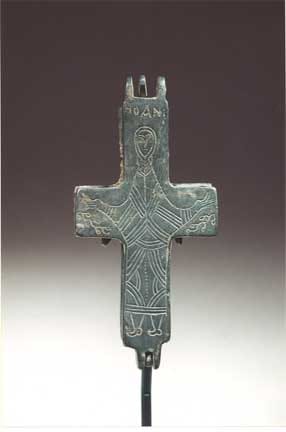Byzantine Silvered Bronze Reliquary Cross with St. John, 8th Century CE - 12th Century CE
Silvered Bronze
height 7.9 cm
height 3 1/8 in
height 3 1/8 in
X.0056
A reliquary is a receptacle for keeping or displaying sacred relics. For Christians, relics were objects connected with saints or the actual physical remains of saints. The veneration of the...
A reliquary is a receptacle for keeping or displaying sacred relics. For Christians, relics were objects connected with saints or the actual physical remains of saints. The veneration of the sacred relics of martyrs is a practice known to date from at least as early as the 2nd century. The Crusades led to an influx of relics from the Middle East and reliquaries became popular items of adornment used for protection by crusaders and the wealthy elite who could afford such luxuries. Although the practice of veneration was defended both by the 13th century theologian St. Thomas Aquinas and by the Council of Trent in the 16th century, the veneration of icons has always had a greater importance in the Eastern Orthodoxy.
This beautiful Byzantine reliquary cross once housed the relics of a Christian martyr, perhaps even St. John himself whose image has been incised onto the front of the cross. The saint stands with his arms outstretched and are identified by the Greek inscription HOANIC above his head; branches with berries are incised below his hands adding a nice decorative element. On the reverse side, incised pyramidal shapes topped by flowers decorate each arm, and in the center is an unidentified bust. This suggestive style heightens the spirituality of the work, for it is the idea of the holiness of the Saint that is the focus, not his physicality. The incised decorations are remarkably vivid and the overall condition of this Latin-shaped reliquary cross is outstanding; notice that the original suspension loop is still intact. The sacred, protective energies of this spectacular reliquary cross continue to radiate outwards, still as potent and powerful as the day it was first worn.
This beautiful Byzantine reliquary cross once housed the relics of a Christian martyr, perhaps even St. John himself whose image has been incised onto the front of the cross. The saint stands with his arms outstretched and are identified by the Greek inscription HOANIC above his head; branches with berries are incised below his hands adding a nice decorative element. On the reverse side, incised pyramidal shapes topped by flowers decorate each arm, and in the center is an unidentified bust. This suggestive style heightens the spirituality of the work, for it is the idea of the holiness of the Saint that is the focus, not his physicality. The incised decorations are remarkably vivid and the overall condition of this Latin-shaped reliquary cross is outstanding; notice that the original suspension loop is still intact. The sacred, protective energies of this spectacular reliquary cross continue to radiate outwards, still as potent and powerful as the day it was first worn.
